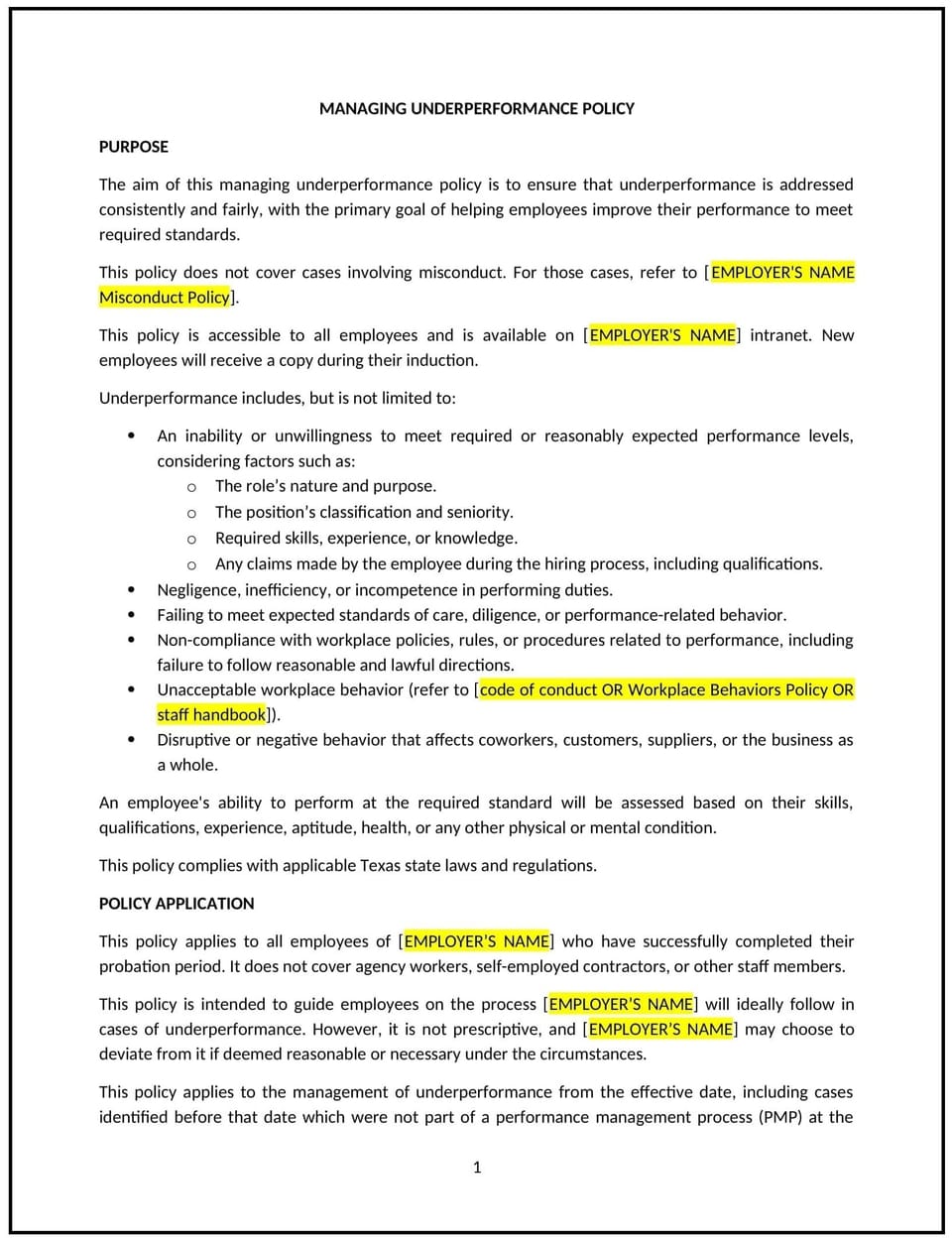Managing underperformance policy (Texas): Free template

Managing underperformance policy (Texas)
This managing underperformance policy is designed to help Texas businesses establish clear guidelines for addressing and managing employee performance issues. The policy provides a structured approach to identifying performance gaps, offering support and training, and implementing corrective actions when necessary to ensure that employees meet the company’s expectations and contribute to its success.
By adopting this policy, businesses can effectively manage underperformance, improve employee productivity, and maintain a positive, high-performance work culture.
How to use this managing underperformance policy (Texas)
- Define underperformance: Clearly specify what constitutes underperformance, such as failing to meet job expectations, missing deadlines, or producing subpar work. The policy should outline specific performance metrics and objectives that employees are expected to meet.
- Set expectations for communication: Establish how managers should communicate performance expectations to employees, including setting clear, measurable goals and providing regular feedback on progress.
- Offer support and training: Identify the resources available to help employees improve performance, including additional training, mentoring, or more frequent check-ins with managers.
- Implement a performance improvement plan (PIP): Outline the process for creating a performance improvement plan (PIP) when underperformance persists. The PIP should specify the goals the employee needs to achieve, the timeline for improvement, and the consequences if the goals are not met.
- Set timelines for review: Establish timelines for monitoring progress, including regular performance reviews or check-ins to assess whether the employee is making the necessary improvements.
- Provide opportunities for feedback: Encourage open communication by giving employees the opportunity to provide feedback on challenges they may be facing and to discuss ways to improve performance collaboratively.
- Define consequences for continued underperformance: Specify the actions the company will take if an employee does not improve their performance, such as reassignment, demotion, or termination, depending on the severity of the situation.
Benefits of using this managing underperformance policy (Texas)
This policy offers several benefits for Texas businesses:
- Improves employee performance: By providing clear guidelines for addressing underperformance, businesses can help employees improve their productivity and reach their full potential.
- Supports employee development: The policy fosters a supportive environment where employees can access training, resources, and feedback to help them succeed.
- Reduces legal risks: The policy ensures that performance issues are handled in a fair, consistent, and legally compliant manner, reducing the risk of discrimination or wrongful termination claims.
- Enhances team dynamics: Addressing underperformance promptly helps prevent negative impacts on team morale, ensuring that all employees are contributing positively to the business.
- Promotes a culture of accountability: A clear, structured approach to managing underperformance reinforces the company’s commitment to high standards and accountability, contributing to a high-performance culture.
Tips for using this managing underperformance policy (Texas)
- Communicate the policy clearly: Ensure that all employees understand the expectations for performance and the process for addressing performance issues. This can be done through the employee handbook, training sessions, or regular team meetings.
- Offer consistent feedback: Provide employees with regular, constructive feedback on their performance, not just when issues arise. Frequent communication can help prevent problems from escalating.
- Use a collaborative approach: Work with employees to identify the root causes of underperformance and provide opportunities for them to improve through training, mentoring, or additional resources.
- Be fair and consistent: Ensure that the policy is applied fairly and consistently to all employees, taking into account individual circumstances and offering support where necessary.
- Document everything: Keep detailed records of all performance discussions, feedback, and actions taken, including any performance improvement plans, to protect the business from potential legal challenges.
Q: What should I do if I notice an employee is underperforming?
A: The first step is to have a candid conversation with the employee to discuss the performance issues. Offer constructive feedback and support, and set clear expectations for improvement. If necessary, put the employee on a performance improvement plan (PIP).
Q: How long should a performance improvement plan (PIP) last?
A: A PIP should typically last between 30 to 90 days, depending on the nature of the performance issues and the time required to make improvements. The policy should specify the timeline and what happens at the end of the PIP.
Q: What happens if the employee does not improve their performance during the PIP?
A: If the employee does not meet the goals outlined in the PIP, the policy should specify the consequences, which may include reassignment, demotion, or termination.
Q: Can an employee be placed on a PIP more than once?
A: The policy should specify whether employees can be placed on a PIP more than once and under what circumstances. If repeated underperformance occurs, more severe corrective actions may be necessary.
Q: How often should this policy be reviewed?
A: The policy should be reviewed annually or whenever there are significant changes in Texas state laws, federal regulations, or business practices that may affect how underperformance is managed.
This article contains general legal information and does not contain legal advice. Cobrief is not a law firm or a substitute for an attorney or law firm. The law is complex and changes often. For legal advice, please ask a lawyer.


